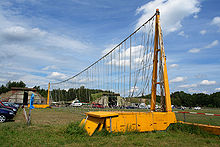Catching system
A catch system (Engl. Arresting gear ) is used to slow aircraft upon landing at a short distance safely.
A distinction is made in how they work
- Rope catching systems and
- Net catching systems
Rope catching system
The functionality of a rope safety system is described in the article Safety rope .
The advantages of the rope trap are
- a large number of “catches” is possible before the steel cable has to be replaced
- the interception system can be used from both directions (so-called "approach end arrestment" [catch at the start of the runway] and "departure end arrestment" [catch at the runway end])
- the interception system is only required for a short time until the landing area is free for the next aircraft - this is particularly important on aircraft carriers.
However, the use of a rope safety system requires a catch hook on the aircraft.
Net catcher
Net safety systems are pure emergency systems in order to slow down an aircraft, which otherwise cannot come to a standstill in time, by means of a safety net that is set up vertically at the end of the runway or the landing deck.
Safety nets are a last resort but can only be used from one direction. In addition, it takes a certain time until the trapped aircraft is released from the network and then the runway can be released again.
The erection of the net takes - depending on the construction - a certain time and therefore requires advance warning.
Furthermore, the use of a net interception system is prohibited on aircraft with sharp edges (e.g. F-104 Starfighter) or after loss or damage to the cabin roof (risk of strangulation for the pilot).
Net catching systems on aircraft carriers
Net catching systems on aircraft carriers serve the same purpose as such systems on land.


